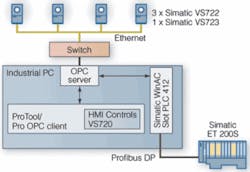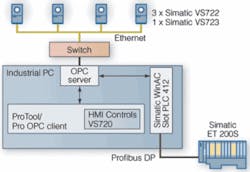Vision ensures quality of seatbelt fasteners
Andrew Wilson, Editor, [email protected]
Wissler & Rademacher (Velbert, Germany; www.wissler-rademacher.de) needed a machine-vision system to perform 100% inspection of seatbelt fasteners at 70 per minute. The company contracted i-controls (Olpe, Germany; www.i-controls.de) and BAT maschinenbau (Meinerzhagen, Germany; www.batmaschinenbau.de) to build an automated inspection system that could detect defects in fractions of a second and reliably eject faulty parts from the system. At Wissler & Rademacher’s request, the machine also needed to be rapidly reconfigured to inspect five different variants of the part.
With the system that was developed, parts are loaded onto a conveyor and the fastening components are viewed from different angles to determine whether elements such as heads, spigots, gates, and hooks are fully formed in the zinc die-casting process and to determine whether any metal burrs have been removed. To do this, the task was distributed over four stations, each of which was equipped with a Simatic VS720 series smart camera from Siemens (Regensburg, Germany; www.automation.siemens.com).
On the first two stations, both side views of the parts are inspected with a resolution of 0.10 mm. While the third camera inspects whether the gates and hooks are properly formed, the fourth camera inspects the most critical part of the hooks at a resolution of 0.003 mm. Since even the slightest misalignment of the parts on the conveyor can alter the perspective considerably, camera-resident algorithms were used to detect whether the fastener’s hooks are correctly formed on both sides.
According to i-controls, the inspection demands placed on the camera located at the third station are particularly high since even the slightest misalignment of the parts on the guide rail can alter the image perspective considerably. To compensate for this possible occurrence, inspection algorithms running on a 200-MHz Simatic 640 × 480 VS723 camera detect whether the hooks located on the fasteners are correctly formed on both sides. Three 50-MHz 640 × 480 VS722 cameras were deployed at the other stations.
To obtain the required resolution in varying ambient lighting conditions, the test stations were equipped with telecentric lenses and LED lighting. After the fourth inspection, defective parts are separated with a compressed-air-based actuator gate, while good parts continue along the conveyor for later packing in specified quantities.
To inspect seatbelt fasteners at speeds of up to 70 per minute, i-controls has developed a system that uses four Ethernet-based smart cameras connected to a PC-based controller and a distributed I/O station.
Controlled by a PC-based Simatic WinAC controller running Windows, the system interfaces to actuators and sensors with a distributed I/O station linked to the system’s PLC over a Profibus interface. All four cameras exchange data with the PLC via an Ethernet switch and an open connectivity server (see figure). Images and results from the cameras are transferred to the host over Ethernet using Siemen’s human machine interface (HMI) controls software. In addition, current measured values and fault counters of the tests are displayed on the operator’s panel. HMI controls allow new test programs to be remotely downloaded. Recorded values can be converted to HMI variables to generate graphs and predict inspection trends.

